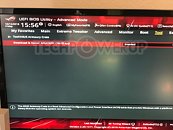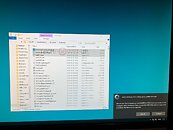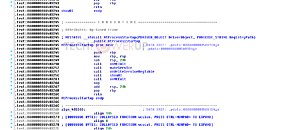Tuesday, October 23rd 2018

ASUS Z390 Motherboards Automatically Push Software into Your Windows Installation
During testing for our Intel Core i9-9900K review we found out that new ASUS Z390 motherboards automatically install software and drivers to your Windows 10 System, without the need for network access, and without any user knowledge or confirmation. This process happens in complete network-isolation (i.e. the machine has no Internet or LAN access). Our Windows 10 image is based on Windows 10 April 2018 Update and lacks in-built drivers for the integrated network controllers.
Upon first boot, with the machine having no LAN or Internet connectivity, we were greeted by an ASUS-specific window in the bottom right corner of our screen, asking whether we'd like to install the network drivers and download "Armoury Crate". This got us curious and we scanned the system for any files that aren't part of the standard MS Windows installation. We discovered three ASUS-signed files in our Windows 10 System32 folder, which, so it seems, magically appeared on our harddrive out of thin air. Upon further investigation we also found a new, already running, system service called "AsusUpdateCheck."These files could not have come from either our Windows image or the network, leaving the motherboard's 16-megabyte UEFI BIOS as the only suspect. The files themselves, which total around 3.6 MB in size, appear harmless, and belong to an ASUS-made program called "ASUS Armoury Crate." This program fetches the latest drivers for your hardware from ASUS servers, and installs them for you in an automated process with little user-intervention. This is a very useful feature, as it establishes a method to install network driver and other drivers easily, without the need for a physical driver disc (in times where nobody has an optical drive anymore). After digging around in the UEFI BIOS, we managed to find a fairly nondescript option "Download and Install ARMOURY CRATE app", which of course defaults to "on"; and it's not easy to find, being located in the "Tool" section of the BIOS setup.
The ASUS UEFI firmware exposes an ACPI table to Windows 10, called "WPBT" or "Windows Platform Binary Table". WPBT is used in the pre-built OEM industry, and is referred to as "the Vendor's Rootkit." Put simply, it is a script that makes Windows copy data from the BIOS to the System32 folder on the machine and execute it during Windows startup - every single time the system is booted. According to the Microsoft WPBT reference, which describes this feature as useful for "anti-theft software", this binary is a "native, user-mode application that is executed by the Windows Session Manager during operating system initialization.", which means "before all other programs, with administrative privileges". This gives pretty much full control over everything, including protected folders and the registry.The ASUS executable unpacks two more files, registers the "AsusUpdateCheck" service and launches it. Once the desktop is loaded, it manifests itself as a bloatware-looking notification near our system tray, requesting you to install the ASUS Armoury Crate software, by fetching the rest of its installer payload from the Internet. Interestingly, it also installs a basic driver to get the integrated network controller working, which is a nice feature. Windows 10 doesn't support the new Z390 integrated Ethernet controller out of the box. This method of writing data to protected areas of the boot drive may not be uncommon with OEM pre-built desktops and notebooks, but for the PC DIY space, in which consumers seek a higher degree of control and privacy over their hardware and software, it is a first and comes across as intrusive. It should normally take a lot of privilege for anything to write to your System32 folder without user-intervention, at least a UAC dialog authenticating the user's consent. Lenovo has used the same method in 2015, which resulted in a huge scandal. They automatically installed a rootkit, which logged data and pushed bloatware into the user's system.
Our motherboard was supplied within the European Union, and yet the software lacks a GPDR-compliant user consent dialog. If nothing else, a person's IP address will be transmitted to ASUS without consent, possibly more, including details like motherboard model, system specs and installed hardware.
We poked and prodded with the service a bit. Deleting the files (and/or the service) simply restores them at the next reboot. Clicking "cancel" in the first instance of the pop-up doesn't end the service, which keeps running in the background until you manually disable it (and it comes back at next reboot). The only way you can ensure the files stay deleted is by disabling the "ASUS Armoury Crate" option in the UEFI setup program, which disables the ACPI-WPBT table. Running the download & install, and then disagreeing with the license agreement will keep Armoury Crate installed on your system. Even when the Armoury Crate Uninstaller is run from "Programs & Software", the AsusUpdateCheck service doesn't get uninstalled, and the uninstaller also forgets to remove a second service it installed.
By default, the ASUS UEFI setup program for our motherboard has the "Download and Install Armoury Crate App" option enabled. Unsuspecting users who glossed over their UEFI setup configuration before installing their OS for the first time, will see the Armoury Crate pop-up even if their machines are not configured to access the Internet. This would do wonders for increasing the user-base of ASUS' software, but are you comfortable with something like this? Given NAND flash pricing, what stops motherboard vendors from embedding a flash-based USB mass-storage device directly onto their motherboards that installs a host of driver software and sponsored bloatware automatically?
If you put aside the privacy concerns for a moment, there are both advantages and disadvantages for what ASUS is trying to accomplish. Since it's enabled by default, this method makes installing drivers and system software easier than ever, since it also gets the network controller to work. It's particularly useful given that motherboard vendors continue to ship drivers on a DVD, and optical disc drives are on the decline, leaving people with little option but to copy their drivers onto a USB flash drive, just to get the NIC working. The application also fetches the very latest (most stable) versions of drivers found on ASUS website. The most obvious disadvantage is cybersecurity. If any of ASUS' on-chip code has security vulnerabilities that can be exploited, there is little way to fix it but with BIOS updates from ASUS.
ASUS needs to make a few changes and release UEFI BIOS updates, on the double. One option could be to disable the Armour Create option in BIOS by default, so unsuspecting users don't get these files. It could be advertised in the home-screen of the UEFI setup instead. Another option could be to properly clean up the installed files if the users chooses to not use Armoury Crate and not install them again on next reboot. Also required is a GPDR-compliant license agreement, that clarifies which data is collected, how it is processed, and whether it is shared with third parties. While this probably won't happen, some kind of ASUS warranty to include liability for any future malware that exploits WPBT to survive OS reinstalls, would go a long way.
We're sure that as a market-leading motherboard vendor, the intentions behind this couldn't have been bad. It only needs a bit of polish, and a lot of transparency with the user.
Upon first boot, with the machine having no LAN or Internet connectivity, we were greeted by an ASUS-specific window in the bottom right corner of our screen, asking whether we'd like to install the network drivers and download "Armoury Crate". This got us curious and we scanned the system for any files that aren't part of the standard MS Windows installation. We discovered three ASUS-signed files in our Windows 10 System32 folder, which, so it seems, magically appeared on our harddrive out of thin air. Upon further investigation we also found a new, already running, system service called "AsusUpdateCheck."These files could not have come from either our Windows image or the network, leaving the motherboard's 16-megabyte UEFI BIOS as the only suspect. The files themselves, which total around 3.6 MB in size, appear harmless, and belong to an ASUS-made program called "ASUS Armoury Crate." This program fetches the latest drivers for your hardware from ASUS servers, and installs them for you in an automated process with little user-intervention. This is a very useful feature, as it establishes a method to install network driver and other drivers easily, without the need for a physical driver disc (in times where nobody has an optical drive anymore). After digging around in the UEFI BIOS, we managed to find a fairly nondescript option "Download and Install ARMOURY CRATE app", which of course defaults to "on"; and it's not easy to find, being located in the "Tool" section of the BIOS setup.
The ASUS UEFI firmware exposes an ACPI table to Windows 10, called "WPBT" or "Windows Platform Binary Table". WPBT is used in the pre-built OEM industry, and is referred to as "the Vendor's Rootkit." Put simply, it is a script that makes Windows copy data from the BIOS to the System32 folder on the machine and execute it during Windows startup - every single time the system is booted. According to the Microsoft WPBT reference, which describes this feature as useful for "anti-theft software", this binary is a "native, user-mode application that is executed by the Windows Session Manager during operating system initialization.", which means "before all other programs, with administrative privileges". This gives pretty much full control over everything, including protected folders and the registry.The ASUS executable unpacks two more files, registers the "AsusUpdateCheck" service and launches it. Once the desktop is loaded, it manifests itself as a bloatware-looking notification near our system tray, requesting you to install the ASUS Armoury Crate software, by fetching the rest of its installer payload from the Internet. Interestingly, it also installs a basic driver to get the integrated network controller working, which is a nice feature. Windows 10 doesn't support the new Z390 integrated Ethernet controller out of the box. This method of writing data to protected areas of the boot drive may not be uncommon with OEM pre-built desktops and notebooks, but for the PC DIY space, in which consumers seek a higher degree of control and privacy over their hardware and software, it is a first and comes across as intrusive. It should normally take a lot of privilege for anything to write to your System32 folder without user-intervention, at least a UAC dialog authenticating the user's consent. Lenovo has used the same method in 2015, which resulted in a huge scandal. They automatically installed a rootkit, which logged data and pushed bloatware into the user's system.
Our motherboard was supplied within the European Union, and yet the software lacks a GPDR-compliant user consent dialog. If nothing else, a person's IP address will be transmitted to ASUS without consent, possibly more, including details like motherboard model, system specs and installed hardware.
We poked and prodded with the service a bit. Deleting the files (and/or the service) simply restores them at the next reboot. Clicking "cancel" in the first instance of the pop-up doesn't end the service, which keeps running in the background until you manually disable it (and it comes back at next reboot). The only way you can ensure the files stay deleted is by disabling the "ASUS Armoury Crate" option in the UEFI setup program, which disables the ACPI-WPBT table. Running the download & install, and then disagreeing with the license agreement will keep Armoury Crate installed on your system. Even when the Armoury Crate Uninstaller is run from "Programs & Software", the AsusUpdateCheck service doesn't get uninstalled, and the uninstaller also forgets to remove a second service it installed.
By default, the ASUS UEFI setup program for our motherboard has the "Download and Install Armoury Crate App" option enabled. Unsuspecting users who glossed over their UEFI setup configuration before installing their OS for the first time, will see the Armoury Crate pop-up even if their machines are not configured to access the Internet. This would do wonders for increasing the user-base of ASUS' software, but are you comfortable with something like this? Given NAND flash pricing, what stops motherboard vendors from embedding a flash-based USB mass-storage device directly onto their motherboards that installs a host of driver software and sponsored bloatware automatically?
If you put aside the privacy concerns for a moment, there are both advantages and disadvantages for what ASUS is trying to accomplish. Since it's enabled by default, this method makes installing drivers and system software easier than ever, since it also gets the network controller to work. It's particularly useful given that motherboard vendors continue to ship drivers on a DVD, and optical disc drives are on the decline, leaving people with little option but to copy their drivers onto a USB flash drive, just to get the NIC working. The application also fetches the very latest (most stable) versions of drivers found on ASUS website. The most obvious disadvantage is cybersecurity. If any of ASUS' on-chip code has security vulnerabilities that can be exploited, there is little way to fix it but with BIOS updates from ASUS.
ASUS needs to make a few changes and release UEFI BIOS updates, on the double. One option could be to disable the Armour Create option in BIOS by default, so unsuspecting users don't get these files. It could be advertised in the home-screen of the UEFI setup instead. Another option could be to properly clean up the installed files if the users chooses to not use Armoury Crate and not install them again on next reboot. Also required is a GPDR-compliant license agreement, that clarifies which data is collected, how it is processed, and whether it is shared with third parties. While this probably won't happen, some kind of ASUS warranty to include liability for any future malware that exploits WPBT to survive OS reinstalls, would go a long way.
We're sure that as a market-leading motherboard vendor, the intentions behind this couldn't have been bad. It only needs a bit of polish, and a lot of transparency with the user.




75 Comments on ASUS Z390 Motherboards Automatically Push Software into Your Windows Installation
They rather install crap on your PC from UEFI without asking for it.
I stopped buying and recommending Gigabyte boards when they started not giving a flying duck about their BIOSes and solely relied on high-end Asus boards, but oh boy are they making it harder to recommend every day over this kind of BS things.
Yet another reason to use Linux...
this you at least know about and have control to disable in BIOS or delete the files, with ME you got no control at all.
www.marketwatch.com/story/asus-computers-infected-by-malicious-auto-update-virus-researchers-warn-2019-03-25
2. There should be a warning sticker on the manual cover
3. Don't see why everyone doesn't do it the Autodesk way .... when you get a system crash, there's a pop up that says to the effect ... "The program has crashed. You file with all progress up to the moment of crash can be recovered by restarting the program and using the "Drawing Recovery Manager". If you'd like to send us information on what caused the crash, hit yes."Not to my knowledge ... Pegatron owns several divisions that used to belong to Asus and still performs services designs and builds products for Asus:
Pagatron aquired AsRock in 2010 shortly before it was spun off from Asus.
Pegatron acquired Unihan Corporation from Asus in January 2008. Since then, the Unihan Corporation has been a subsidiary of Pegatron Corporation that designs and manufactures computers, peripherals, and audio-video products .
Asus Laptops are made by Pegatron
PEGA Design and Engineering is Pegatron's design team that used to be the Asus design team. The PEGA D&E helps Pegatron's clients (including Asus) do product development, market research, conceptualization, product design, materials study and production.
For a time, Pegatron was handling Asus' Tech Support and RMA processes .... I believe this stopped around 2015 as emails on Asus TS inquiries that I get no longer come from Pegatron.com
PEGA CASA design team (again formerly the Asus design team) does design for notebooks, smartphone, e-books, network communication equipment, displays, projectors, cleaning robots, home appliances , fashion and vehicle accessories), building interior design and building materials, multimedia ads and marketing and spo on.I understand the concern.... If my neighbor asks to borrow my lawnmower, I'll say grab it , its in the garage and he does... I'm fine with that. If he takes it without my knowledge or consent, then Im pissed.
Asus used to do this very well ... along with many other things. Not so much anymore. Provide a DVD or USB stick which instals a set up utility ONLY. Uon installation, it opens a small window (1 of 4) ... the 1st thing in that window should be an option to a) Install PDF Reader and b) "Open Manual". The 2nd window should be a drop down listing all drivers with checkboxes so you can install what ya want. Clicking on each driver should open a description of the driver, what it does and potential issues. The 3rd window should be all utilities w/ same features as above. The 4th window should have TS info.
Opening the setup utility at any time should present that same page 2 / 3 where the same check boxes are present listing each driver with 2 columns of checkboxes
A) Installed .... driver version listed for each installed driver
B) Upgrade Available ... list new driver version
With a check in the box, it's installed when ya hit "Install / Uninstall All Items" button... unchecked boxes get uninstalled.
Notwithstanding the privacy and security concerns, I welcome such software. I do think motherboard manufacturers need to provide a built-in software for automatically managing driver and firmware updates (which can be a security feature too), like what the big system integrator offer.